Soy Leghemoglobin Market
Soy Leghemoglobin Market Size and Share Forecast Outlook 2025 to 2035
Soy leghemoglobin market is projected to grow from USD 180.0 billion in 2025 to USD 511.1 billion by 2035, at a CAGR of 11.0%. Plant-Based Meat will dominate with a 71.0% market share, while liquid concentrate will lead the form segment with a 58.0% share.
Soy Leghemoglobin Market Forecast and Outlook 2025 to 2035
The global soy leghemoglobin market is valued at USD 180 million in 2025. It is slated to reach USD 511.1 million by 2035, recording an absolute increase of USD 340.0 million over the forecast period. This translates into a total growth of 188.9%, with the market forecast to expand at a compound annual growth rate (CAGR) of 11% between 2025 and 2035.
The overall market size is expected to grow by nearly 2.89X during the same period, supported by rapidly expanding plant-based meat industry, increasing consumer demand for meat alternatives, growing investment in alternative protein technologies, and rising adoption of bleeding burger innovations in food service channels.
Quick Stats for Soy Leghemoglobin Market
- Soy Leghemoglobin Market Value (2025): USD 180 million
- Soy Leghemoglobin Market Forecast Value (2035): USD 511.1 million
- Soy Leghemoglobin Market Forecast CAGR: 11%
- Leading Form Type in Soy Leghemoglobin Market: Liquid Concentrate
- Key Growth Regions in Soy Leghemoglobin Market: North America, Europe, and Asia-Pacific
- Key Players in Soy Leghemoglobin Market: Impossible Foods, Motif FoodWorks, Ginkgo Bioworks, DSM Firmenich, ADM, Kerry
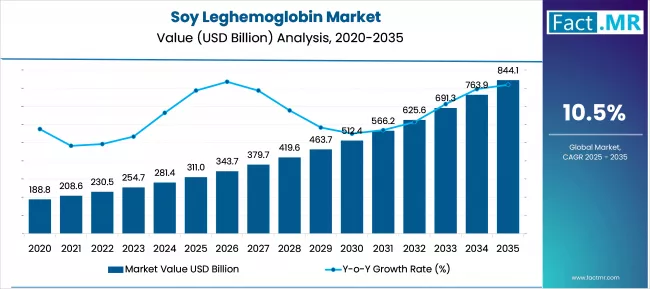
Between 2025 and 2030, the soy leghemoglobin market is projected to expand from USD 180 million to USD 320 million, resulting in a value increase of USD 140.0 million, which represents 41.2% of the total forecast growth for the decade. This phase of development will be shaped by increasing mainstream adoption of plant-based meat products, expanding food service applications, and growing consumer acceptance of bleeding plant-based burgers. Alternative protein companies and food manufacturers are expanding their soy leghemoglobin capabilities to address the growing demand for realistic meat alternative experiences.
Soy Leghemoglobin Market Key Takeaways
| Metric | Value |
|---|---|
| Estimated Value in (2025E) | USD 180 million |
| Forecast Value in (2035F) | USD 511.1 million |
| Forecast CAGR (2025 to 2035) | 11% |
From 2030 to 2035, the market is forecast to grow from USD 320 million to USD 511.1 million, adding another USD 200.0 million, which constitutes 58.8% of the overall ten-year expansion. This period is expected to be characterized by the expansion of production scale and cost optimization, development of new application areas beyond meat alternatives, and growth of international market penetration and regulatory approvals. The growing adoption of biotechnology innovations and precision fermentation will drive demand for soy leghemoglobin with enhanced functionality and cost-effectiveness.
Between 2020 and 2025, the soy leghemoglobin market experienced explosive growth, driven by breakthrough innovations in plant-based meat technology and growing recognition of soy leghemoglobin as the key ingredient enabling realistic meat-like experiences in plant-based products. The market developed as food manufacturers and consumers recognized the potential for soy leghemoglobin to revolutionize plant-based meat by providing authentic bleeding characteristics, enhanced flavor profiles, and improved sensory experiences that closely mimic conventional meat products.
Why is the Soy Leghemoglobin Market Growing?
Market expansion is being supported by the rapidly growing plant-based meat industry driven by environmental concerns and health consciousness, alongside the corresponding need for innovative ingredients that can provide authentic meat-like experiences, enhance product differentiation, and support consumer acceptance of plant-based alternatives across various food service and retail applications. Modern alternative protein companies and food manufacturers are increasingly focused on implementing soy leghemoglobin solutions that can improve product authenticity, attract flexitarian consumers, and provide competitive advantages in the rapidly expanding plant-based meat market.
The growing emphasis on sustainable food systems and environmental responsibility is driving demand for soy leghemoglobin that can support reduced animal agriculture impact, enable scalable alternative protein production, and ensure comprehensive sustainability benefits. Food manufacturers' preference for ingredients that combine sensory innovation with environmental credentials and consumer appeal is creating opportunities for innovative soy leghemoglobin implementations. The rising influence of flexitarian diets and mainstream plant-based adoption is also contributing to increased demand for soy leghemoglobin that can provide superior meat-like characteristics without compromising taste or consumer satisfaction.
Segmental Analysis
The market is segmented by application, form, and distribution channel. By application, the market is divided into plant-based meat, sauces & flavors, and others. Based on form, the market is categorized into liquid concentrate and powder. By distribution channel, the market is segmented into B2B ingredient and retail channels.
By Application, the Plant-Based Meat Segment Dominates the Market
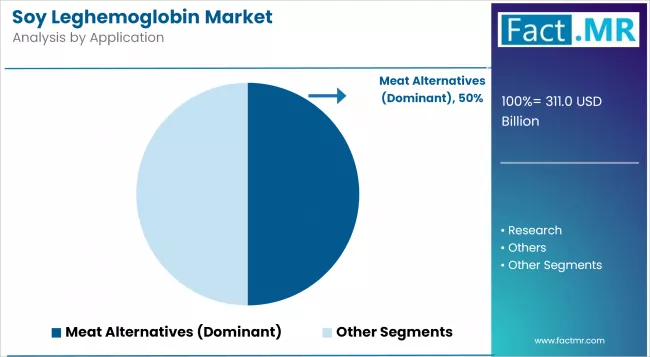
The plant-based meat segment is projected to maintain its leading position in the soy leghemoglobin market in 2025 with a 71% market share, reaffirming its role as the primary application driving soy leghemoglobin demand and plant-based meat innovation. Alternative protein companies and food manufacturers increasingly utilize soy leghemoglobin in plant-based meat products for its revolutionary ability to create bleeding characteristics, enhance flavor profiles, and provide authentic meat-like experiences that attract mainstream consumers and differentiate products in competitive markets. Plant-based meat application's proven effectiveness and market impact directly address industry requirements for realistic meat alternatives and consumer acceptance across diverse food service and retail environments.
This application segment forms the foundation of soy leghemoglobin commercialization, as it represents the application with the greatest contribution to market growth and established consumer recognition across multiple plant-based meat categories and consumption occasions. Alternative protein industry investments in plant-based meat innovations continue to strengthen soy leghemoglobin adoption among manufacturers and brands. With consumer preferences requiring authentic meat-like experiences in plant-based products, soy leghemoglobin aligns with both sensory objectives and market differentiation requirements, making it the central component of comprehensive plant-based meat strategies.
By Form, the Liquid Concentrate Segment Leads Market Preference
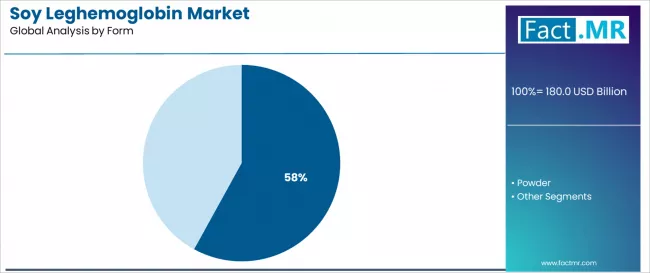
The liquid concentrate form segment is projected to represent the largest share of soy leghemoglobin demand in 2025 with a 58% market share, underscoring its preferred format for food manufacturing applications due to ease of incorporation, consistent performance, and optimal functionality in plant-based meat formulations. Manufacturers prefer liquid concentrate forms for their superior mixing characteristics, precise dosing capabilities, and ability to maintain product integrity while supporting efficient manufacturing processes. Positioned as the optimal form for commercial food production, liquid concentrates offer both processing advantages and performance benefits.
The segment is supported by continuous innovation in biotechnology production and the growing availability of specialized liquid formulations that enable superior product performance with enhanced stability and manufacturing efficiency. Additionally, alternative protein manufacturers are investing in comprehensive processing optimization programs to support increasingly sophisticated soy leghemoglobin applications and production scaling requirements. As plant-based meat production scales and efficiency demands increase, the liquid concentrate form will continue to dominate the market while supporting advanced manufacturing strategies and cost optimization.
What are the Drivers, Restraints, and Key Trends of the Soy Leghemoglobin Market?
The soy leghemoglobin market is advancing rapidly due to explosive growth in plant-based meat consumption driven by environmental awareness and flexitarian diet adoption, alongside increasing demand for innovative ingredients that can provide authentic meat-like sensory experiences, support product differentiation, and enable mainstream consumer acceptance of plant-based alternatives across food service and retail channels. However, the market faces challenges, including high production costs and limited manufacturing capacity, regulatory approval requirements in various markets, and consumer unfamiliarity with biotechnology-derived ingredients. Innovation in production scaling technologies and cost optimization continues to influence market accessibility and expansion patterns.
Expansion of Plant-Based Meat Mainstream Adoption
The growing mainstream adoption of plant-based meat products is driving demand for soy leghemoglobin that can deliver authentic bleeding characteristics, enhanced umami flavors, and realistic meat-like experiences that satisfy both dedicated plant-based consumers and flexitarian mainstream audiences. Food service operators and retailers require plant-based meat products with soy leghemoglobin that provide superior sensory appeal across multiple preparation methods while maintaining consumer satisfaction and repeat purchase behavior. Alternative protein companies are increasingly recognizing the competitive advantages of soy leghemoglobin integration for market penetration and consumer conversion, creating opportunities for specialized applications designed for diverse culinary applications and consumer preferences.
Integration of Biotechnology Innovation and Production Scaling
Modern soy leghemoglobin manufacturers are incorporating advanced biotechnology methods and production scaling technologies to enhance cost-effectiveness, improve manufacturing efficiency, and support comprehensive commercialization objectives through precision fermentation, process optimization, and supply chain development. Leading companies are developing scalable production systems, implementing cost reduction strategies, and advancing biotechnology platforms that maximize yield while maintaining ingredient quality and functionality. These technologies improve commercial viability while enabling new market opportunities, including cost-competitive applications, expanded product categories, and international market development.
Development of New Applications and Product Categories
The expansion of soy leghemoglobin applications beyond traditional plant-based burgers is driving demand for innovative uses in sauces, flavoring systems, and specialty food products that can benefit from enhanced umami characteristics and bleeding visual effects. These emerging applications require specialized formulation capabilities and application development that extend beyond traditional meat alternative uses, creating new market segments with differentiated value propositions. Manufacturers are investing in application research and product development to serve emerging food categories while supporting innovation in flavor technology and culinary applications.
Analysis of the Soy Leghemoglobin Market by Key Countries
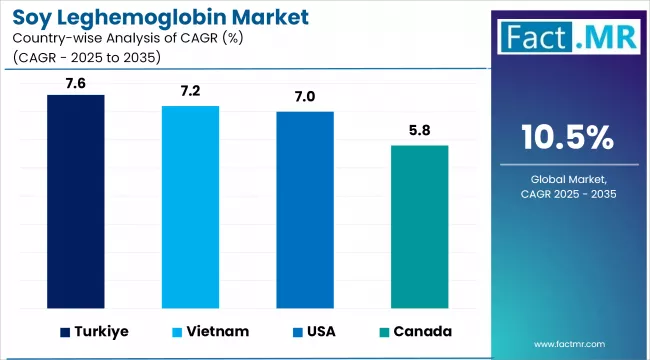
| Country | CAGR (2025-2035) |
|---|---|
| USA | 12.4% |
| Mexico | 11.6% |
| Germany | 10.8% |
| France | 10.2% |
| UK | 9.8% |
| South Korea | 9.3% |
| Japan | 8.9% |
The soy leghemoglobin market is experiencing exceptional growth globally, with the USA leading at a 12.4% CAGR through 2035, driven by pioneering plant-based meat innovation, extensive alternative protein investment, and strong consumer acceptance of bleeding plant-based burgers supporting soy leghemoglobin adoption. Mexico follows at 11.6%, supported by growing plant-based food interest, expanding food service applications, and increasing consumer awareness of alternative proteins. Germany shows growth at 10.8%, emphasizing sustainability focus, plant-based market development, and environmental consciousness driving alternative protein adoption. France demonstrates 10.2% growth, supported by culinary innovation, premium food trends, and growing flexitarian consumer base. The UK records 9.8%, focusing on plant-based market leadership, sustainability trends, and innovative food technology adoption. South Korea exhibits 9.3% growth, emphasizing food technology innovation and premium alternative proteins. Japan shows 8.9% growth, supported by food technology advancement and quality alternative protein appreciation.
USA Leads Global Market Growth with Plant-Based Innovation Leadership

Revenue from soy leghemoglobin in the USA is projected to exhibit exceptional growth with a CAGR of 12.4% through 2035, driven by pioneering plant-based meat innovation and extensive alternative protein investment supporting soy leghemoglobin adoption among leading food technology companies, alternative protein startups, and mainstream food manufacturers. The country's established biotechnology infrastructure and consumer acceptance of innovative food technologies are creating substantial demand for soy leghemoglobin solutions. Major alternative protein companies and food manufacturers are establishing comprehensive production and application capabilities to serve both domestic markets and global expansion opportunities.
- Strong alternative protein investment and biotechnology innovation are driving demand for soy leghemoglobin throughout plant-based meat manufacturers, food service operators, and retail chains across urban markets, innovation hubs, and mainstream food channels.
- Growing consumer acceptance and mainstream plant-based adoption are supporting the rapid development of soy leghemoglobin applications among companies seeking product differentiation, sensory enhancement, and market leadership in the expanding alternative protein sector.
Mexico Demonstrates Strong Market Potential with Food Service Expansion
Revenue from soy leghemoglobin in Mexico is expanding at a CAGR of 11.6%, supported by the country's growing plant-based food interest, expanding food service applications, and increasing consumer awareness of alternative proteins and sustainable food options. The country's evolving food culture and restaurant innovation are driving demand for innovative plant-based ingredients throughout urban centers and progressive food service establishments. Leading food service companies and alternative protein importers are establishing comprehensive distribution networks to address growing demand for realistic plant-based meat experiences.
- Rising plant-based food interest and expanding food service sector are creating opportunities for soy leghemoglobin adoption across progressive restaurants, food chains, and culinary innovation centers in major urban markets and tourist destinations.
- Growing consumer awareness and culinary experimentation are driving adoption of innovative plant-based ingredients among food service operators seeking differentiation, sustainability positioning, and appeal to environmentally conscious consumers.
Germany Demonstrates Sustainability Leadership with Environmental Focus
Revenue from soy leghemoglobin in Germany is expanding at a CAGR of 10.8%, driven by the country's strong sustainability focus, comprehensive environmental consciousness, and leadership in plant-based market development supporting innovative alternative protein adoption. Germany's environmental awareness and sustainable food trends are driving demand for revolutionary plant-based ingredients. Leading sustainable food companies and environmental retailers are establishing comprehensive innovation programs for next-generation plant-based products.
- Advanced sustainability consciousness and environmental food trends are creating demand for innovative soy leghemoglobin applications among environmentally focused consumers seeking authentic plant-based experiences and reduced environmental impact.
- Strong plant-based market development and environmental leadership are supporting the adoption of breakthrough biotechnology ingredients across sustainable food channels, environmental retail outlets, and progressive food service venues throughout major urban and environmental regions.
France Focuses on Culinary Innovation and Premium Food Excellence
Revenue from soy leghemoglobin in France is expanding at a CAGR of 10.2%, driven by the country's culinary innovation leadership, premium food culture, and sophisticated approach to alternative protein development supporting soy leghemoglobin integration into French culinary excellence and gourmet food applications. France's gastronomic sophistication and innovation focus are supporting investment in premium alternative protein technologies. Major culinary companies and gourmet food innovators are establishing comprehensive programs incorporating advanced food technologies with French culinary expertise.
- Advanced culinary innovation and premium food culture are creating demand for sophisticated soy leghemoglobin applications throughout gourmet restaurants, culinary innovation centers, and premium food retailers serving culinary enthusiasts and food technology adopters.
- Strong gastronomic traditions and innovation leadership are driving the adoption of cutting-edge food technologies across high-end culinary applications, gourmet food development, and premium alternative protein offerings throughout major culinary and innovation regions.
UK Shows Market Leadership with Plant-Based Innovation
Revenue from soy leghemoglobin in the UK is expanding at a CAGR of 9.8%, supported by the country's plant-based market leadership, strong sustainability trends, and innovative food technology adoption supporting soy leghemoglobin utilization across diverse alternative protein and food innovation applications. The UK's plant-based market maturity and innovation acceptance are driving demand for breakthrough alternative protein ingredients. Leading plant-based companies and food innovators are investing in advanced ingredient technologies and market development for progressive consumers.
- Advanced plant-based market development and sustainability trends are creating opportunities for soy leghemoglobin applications throughout plant-based food manufacturers, innovative restaurants, and progressive retail channels serving sustainability-focused consumer segments.
- Strong food technology innovation and alternative protein leadership are driving the adoption of advanced biotechnology ingredients across plant-based product development, culinary innovation, and sustainable food systems targeting environmentally conscious consumers.
South Korea Demonstrates Technology Leadership with Food Innovation
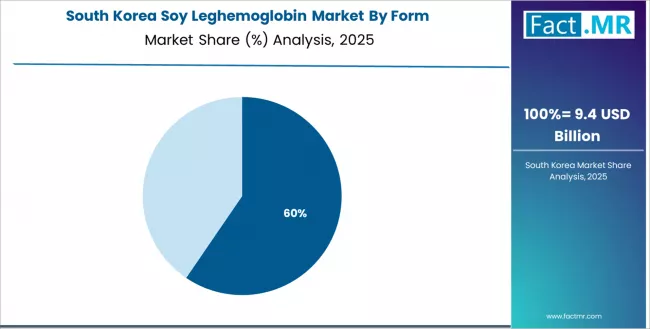
Revenue from soy leghemoglobin in South Korea is expanding at a CAGR of 9.3%, supported by the country's food technology innovation, biotechnology advancement, and growing emphasis on premium alternative proteins and innovative food experiences supporting advanced soy leghemoglobin adoption. The nation's technological sophistication and innovation culture are driving demand for cutting-edge food ingredients. Leading biotechnology companies are investing extensively in food technology development and alternative protein market expansion.
- Advanced food technology capabilities and innovation culture are creating demand for sophisticated soy leghemoglobin applications throughout biotechnology companies, innovative food manufacturers, and premium food service establishments.
- Strong biotechnology focus and food innovation leadership are supporting the adoption of advanced biotechnology ingredients designed for food technology applications, premium alternative proteins, and innovative culinary experiences across diverse consumer segments.
Japan Shows Premium Focus with Food Technology Excellence
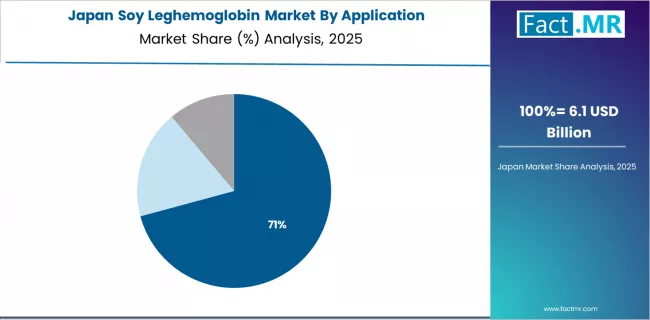
Revenue from soy leghemoglobin in Japan is expanding at a CAGR of 8.9%, supported by the country's food technology advancement, quality food culture, and strong emphasis on innovative food ingredients and premium alternative protein applications supporting soy leghemoglobin adoption for food technology excellence. Japan's technological precision and quality consciousness are driving demand for premium biotechnology ingredients. Leading food technology and biotechnology companies are investing in specialized capabilities for advanced food applications and quality alternative protein development.
- Advanced food technology capabilities and quality consciousness are creating opportunities for soy leghemoglobin applications throughout food technology companies, premium alternative protein manufacturers, and quality-focused food service establishments.
- Strong technological excellence and innovation focus are driving adoption of cutting-edge biotechnology ingredients meeting Japanese standards for food technology innovation, quality assurance, and comprehensive functionality across diverse food technology applications.
Europe Market Split by Country
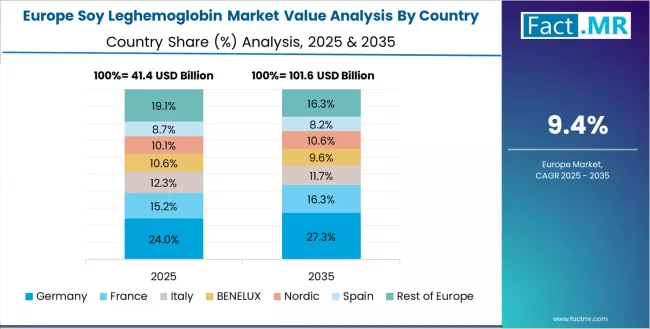
The soy leghemoglobin market in Europe is projected to grow from USD 45.0 million in 2025 to USD 125.0 million by 2035, registering a CAGR of 10.7% over the forecast period. Germany is expected to maintain leadership with a 32.2% market share in 2025, moderating to 31.8% by 2035, supported by sustainability focus, environmental consciousness, and comprehensive plant-based market development.
France follows with 24.4% in 2025, projected to reach 24.8% by 2035, driven by culinary innovation leadership, premium food culture, and sophisticated alternative protein development. The United Kingdom holds 21.3% in 2025, expected to reach 21.6% by 2035 due to plant-based market leadership and innovative food technology adoption. Italy commands 13.3% in 2025, rising to 13.4% by 2035, while Spain accounts for 5.8% in 2025, reaching 5.9% by 2035. The Rest of Europe region is anticipated to hold 3.0% in 2025 and 2.5% by 2035, reflecting emerging biotechnology and alternative protein market development in Nordic countries and progressive Eastern European markets implementing food innovation programs.
Competitive Landscape of the Soy Leghemoglobin Market

The soy leghemoglobin market is characterized by competition among biotechnology pioneers, alternative protein companies, and specialized ingredient manufacturers. Companies are investing in production scaling technology development, cost optimization research, regulatory approval processes, and application development to deliver effective, affordable, and commercially viable soy leghemoglobin solutions. Innovation in precision fermentation, biotechnology production, and application optimization is central to strengthening market position and competitive advantage.
Impossible Foods leads the market with a 56.0% share, being the pioneer and primary developer of soy leghemoglobin technology with comprehensive patent portfolio, production capabilities, and application expertise across plant-based meat and food service applications. The company continues investing in production scaling, cost reduction, and application development while expanding international market penetration and regulatory approvals. Motif FoodWorks provides innovative food technology solutions with emphasis on alternative protein ingredients. Ginkgo Bioworks offers biotechnology platform services for ingredient development. DSM Firmenich focuses on nutritional and biotechnology ingredients. ADM emphasizes agricultural biotechnology and ingredient solutions. Kerry specializes in food ingredient innovation and application development.
Key Players in the Soy Leghemoglobin Market
- Impossible Foods
- Motif FoodWorks
- Ginkgo Bioworks
- DSM Firmenich
- ADM
- Kerry
- Ingredion
- Cargill
- Symrise
- IFF
Scope of the Report
| Items | Values |
|---|---|
| Quantitative Units (2025) | USD 180 million |
| Application | Plant-Based Meat, Sauces & Flavors, Others |
| Form | Liquid Concentrate, Powder |
| Distribution Channel | B2B Ingredient, Retail |
| Regions Covered | North America, Europe, Asia-Pacific, Latin America, Middle East & Africa |
| Countries Covered | USA, Mexico, Germany, France, UK, Japan, South Korea, and 40+ countries |
| Key Companies Profiled | Impossible Foods, Motif FoodWorks, Ginkgo Bioworks, DSM Firmenich, ADM, Kerry |
| Additional Attributes | Dollar sales by application and form, regional demand trends, competitive landscape, biotechnology advancement, production scaling development, cost optimization research, and application innovation |
Soy Leghemoglobin Market by Segments
-
Application :
- Plant-Based Meat
- Sauces & Flavors
- Others
-
Form :
- Liquid Concentrate
- Powder
-
Distribution Channel :
- B2B Ingredient
- Retail
-
Region :
-
North America
- United States
- Canada
- Mexico
-
Europe
- Germany
- United Kingdom
- France
- Italy
- Spain
- Netherlands
- Rest of Europe
-
Asia-Pacific
- Japan
- South Korea
- China
- India
- Australia
- Rest of Asia-Pacific
-
Latin America
- Brazil
- Argentina
- Rest of Latin America
-
Middle East & Africa
- Kingdom of Saudi Arabia
- South Africa
- Rest of Middle East & Africa
-
Table of Content
- Executive Summary
- Global Market Outlook
- Demand to side Trends
- Supply to side Trends
- Technology Roadmap Analysis
- Analysis and Recommendations
- Market Overview
- Market Coverage / Taxonomy
- Market Definition / Scope / Limitations
- Market Background
- Market Dynamics
- Drivers
- Restraints
- Opportunity
- Trends
- Scenario Forecast
- Demand in Optimistic Scenario
- Demand in Likely Scenario
- Demand in Conservative Scenario
- Opportunity Map Analysis
- Product Life Cycle Analysis
- Supply Chain Analysis
- Investment Feasibility Matrix
- Value Chain Analysis
- PESTLE and Porter’s Analysis
- Regulatory Landscape
- Regional Parent Market Outlook
- Production and Consumption Statistics
- Import and Export Statistics
- Market Dynamics
- Global Market Analysis 2020 to 2024 and Forecast, 2025 to 2035
- Historical Market Size Value (USD Million) Analysis, 2020 to 2024
- Current and Future Market Size Value (USD Million) Projections, 2025 to 2035
- Y to o to Y Growth Trend Analysis
- Absolute $ Opportunity Analysis
- Global Market Pricing Analysis 2020 to 2024 and Forecast 2025 to 2035
- Global Market Analysis 2020 to 2024 and Forecast 2025 to 2035, By Application
- Introduction / Key Findings
- Historical Market Size Value (USD Million) Analysis By Application , 2020 to 2024
- Current and Future Market Size Value (USD Million) Analysis and Forecast By Application , 2025 to 2035
- Plant-Based Meat
- Sauces & Flavors
- Others
- Y to o to Y Growth Trend Analysis By Application , 2020 to 2024
- Absolute $ Opportunity Analysis By Application , 2025 to 2035
- Global Market Analysis 2020 to 2024 and Forecast 2025 to 2035, By Form
- Introduction / Key Findings
- Historical Market Size Value (USD Million) Analysis By Form, 2020 to 2024
- Current and Future Market Size Value (USD Million) Analysis and Forecast By Form, 2025 to 2035
- Liquid Concentrate
- Powder
- Y to o to Y Growth Trend Analysis By Form, 2020 to 2024
- Absolute $ Opportunity Analysis By Form, 2025 to 2035
- Global Market Analysis 2020 to 2024 and Forecast 2025 to 2035, By Region
- Introduction
- Historical Market Size Value (USD Million) Analysis By Region, 2020 to 2024
- Current Market Size Value (USD Million) Analysis and Forecast By Region, 2025 to 2035
- North America
- Latin America
- Western Europe
- Eastern Europe
- East Asia
- South Asia and Pacific
- Middle East & Africa
- Market Attractiveness Analysis By Region
- North America Market Analysis 2020 to 2024 and Forecast 2025 to 2035, By Country
- Historical Market Size Value (USD Million) Trend Analysis By Market Taxonomy, 2020 to 2024
- Market Size Value (USD Million) Forecast By Market Taxonomy, 2025 to 2035
- By Country
- USA
- Canada
- Mexico
- By Application
- By Form
- By Country
- Market Attractiveness Analysis
- By Country
- By Application
- By Form
- Key Takeaways
- Latin America Market Analysis 2020 to 2024 and Forecast 2025 to 2035, By Country
- Historical Market Size Value (USD Million) Trend Analysis By Market Taxonomy, 2020 to 2024
- Market Size Value (USD Million) Forecast By Market Taxonomy, 2025 to 2035
- By Country
- Brazil
- Chile
- Rest of Latin America
- By Application
- By Form
- By Country
- Market Attractiveness Analysis
- By Country
- By Application
- By Form
- Key Takeaways
- Western Europe Market Analysis 2020 to 2024 and Forecast 2025 to 2035, By Country
- Historical Market Size Value (USD Million) Trend Analysis By Market Taxonomy, 2020 to 2024
- Market Size Value (USD Million) Forecast By Market Taxonomy, 2025 to 2035
- By Country
- Germany
- UK
- Italy
- Spain
- France
- Nordic
- BENELUX
- Rest of Western Europe
- By Application
- By Form
- By Country
- Market Attractiveness Analysis
- By Country
- By Application
- By Form
- Key Takeaways
- Eastern Europe Market Analysis 2020 to 2024 and Forecast 2025 to 2035, By Country
- Historical Market Size Value (USD Million) Trend Analysis By Market Taxonomy, 2020 to 2024
- Market Size Value (USD Million) Forecast By Market Taxonomy, 2025 to 2035
- By Country
- Russia
- Poland
- Hungary
- Balkan & Baltic
- Rest of Eastern Europe
- By Application
- By Form
- By Country
- Market Attractiveness Analysis
- By Country
- By Application
- By Form
- Key Takeaways
- East Asia Market Analysis 2020 to 2024 and Forecast 2025 to 2035, By Country
- Historical Market Size Value (USD Million) Trend Analysis By Market Taxonomy, 2020 to 2024
- Market Size Value (USD Million) Forecast By Market Taxonomy, 2025 to 2035
- By Country
- China
- Japan
- South Korea
- By Application
- By Form
- By Country
- Market Attractiveness Analysis
- By Country
- By Application
- By Form
- Key Takeaways
- South Asia and Pacific Market Analysis 2020 to 2024 and Forecast 2025 to 2035, By Country
- Historical Market Size Value (USD Million) Trend Analysis By Market Taxonomy, 2020 to 2024
- Market Size Value (USD Million) Forecast By Market Taxonomy, 2025 to 2035
- By Country
- India
- ASEAN
- Australia & New Zealand
- Rest of South Asia and Pacific
- By Application
- By Form
- By Country
- Market Attractiveness Analysis
- By Country
- By Application
- By Form
- Key Takeaways
- Middle East & Africa Market Analysis 2020 to 2024 and Forecast 2025 to 2035, By Country
- Historical Market Size Value (USD Million) Trend Analysis By Market Taxonomy, 2020 to 2024
- Market Size Value (USD Million) Forecast By Market Taxonomy, 2025 to 2035
- By Country
- Kingdom of Saudi Arabia
- Other GCC Countries
- Turkiye
- South Africa
- Other African Union
- Rest of Middle East & Africa
- By Application
- By Form
- By Country
- Market Attractiveness Analysis
- By Country
- By Application
- By Form
- Key Takeaways
- Key Countries Market Analysis
- USA
- Pricing Analysis
- Market Share Analysis, 2024
- By Application
- By Form
- Canada
- Pricing Analysis
- Market Share Analysis, 2024
- By Application
- By Form
- Mexico
- Pricing Analysis
- Market Share Analysis, 2024
- By Application
- By Form
- Brazil
- Pricing Analysis
- Market Share Analysis, 2024
- By Application
- By Form
- Chile
- Pricing Analysis
- Market Share Analysis, 2024
- By Application
- By Form
- Germany
- Pricing Analysis
- Market Share Analysis, 2024
- By Application
- By Form
- UK
- Pricing Analysis
- Market Share Analysis, 2024
- By Application
- By Form
- Italy
- Pricing Analysis
- Market Share Analysis, 2024
- By Application
- By Form
- Spain
- Pricing Analysis
- Market Share Analysis, 2024
- By Application
- By Form
- France
- Pricing Analysis
- Market Share Analysis, 2024
- By Application
- By Form
- India
- Pricing Analysis
- Market Share Analysis, 2024
- By Application
- By Form
- ASEAN
- Pricing Analysis
- Market Share Analysis, 2024
- By Application
- By Form
- Australia & New Zealand
- Pricing Analysis
- Market Share Analysis, 2024
- By Application
- By Form
- China
- Pricing Analysis
- Market Share Analysis, 2024
- By Application
- By Form
- Japan
- Pricing Analysis
- Market Share Analysis, 2024
- By Application
- By Form
- South Korea
- Pricing Analysis
- Market Share Analysis, 2024
- By Application
- By Form
- Russia
- Pricing Analysis
- Market Share Analysis, 2024
- By Application
- By Form
- Poland
- Pricing Analysis
- Market Share Analysis, 2024
- By Application
- By Form
- Hungary
- Pricing Analysis
- Market Share Analysis, 2024
- By Application
- By Form
- Kingdom of Saudi Arabia
- Pricing Analysis
- Market Share Analysis, 2024
- By Application
- By Form
- Turkiye
- Pricing Analysis
- Market Share Analysis, 2024
- By Application
- By Form
- South Africa
- Pricing Analysis
- Market Share Analysis, 2024
- By Application
- By Form
- USA
- Market Structure Analysis
- Competition Dashboard
- Competition Benchmarking
- Market Share Analysis of Top Players
- By Regional
- By Application
- By Form
- Competition Analysis
- Competition Deep Dive
- Impossible Foods
- Overview
- Product Portfolio
- Profitability by Market Segments (Product/Age /Sales Channel/Region)
- Sales Footprint
- Strategy Overview
- Marketing Strategy
- Product Strategy
- Channel Strategy
- Motif FoodWorks
- Ginkgo Bioworks
- DSM Firmenich
- ADM
- Kerry
- Ingredion
- Cargill
- Symrise
- IFF
- Impossible Foods
- Competition Deep Dive
- Assumptions & Acronyms Used
- Research Methodology
List Of Table
- Table 1: Global Market Value (USD Million) Forecast by Region, 2020 to 2035
- Table 2: Global Market Value (USD Million) Forecast by Application , 2020 to 2035
- Table 3: Global Market Value (USD Million) Forecast by Form, 2020 to 2035
- Table 4: North America Market Value (USD Million) Forecast by Country, 2020 to 2035
- Table 5: North America Market Value (USD Million) Forecast by Application , 2020 to 2035
- Table 6: North America Market Value (USD Million) Forecast by Form, 2020 to 2035
- Table 7: Latin America Market Value (USD Million) Forecast by Country, 2020 to 2035
- Table 8: Latin America Market Value (USD Million) Forecast by Application , 2020 to 2035
- Table 9: Latin America Market Value (USD Million) Forecast by Form, 2020 to 2035
- Table 10: Western Europe Market Value (USD Million) Forecast by Country, 2020 to 2035
- Table 11: Western Europe Market Value (USD Million) Forecast by Application , 2020 to 2035
- Table 12: Western Europe Market Value (USD Million) Forecast by Form, 2020 to 2035
- Table 13: Eastern Europe Market Value (USD Million) Forecast by Country, 2020 to 2035
- Table 14: Eastern Europe Market Value (USD Million) Forecast by Application , 2020 to 2035
- Table 15: Eastern Europe Market Value (USD Million) Forecast by Form, 2020 to 2035
- Table 16: East Asia Market Value (USD Million) Forecast by Country, 2020 to 2035
- Table 17: East Asia Market Value (USD Million) Forecast by Application , 2020 to 2035
- Table 18: East Asia Market Value (USD Million) Forecast by Form, 2020 to 2035
- Table 19: South Asia and Pacific Market Value (USD Million) Forecast by Country, 2020 to 2035
- Table 20: South Asia and Pacific Market Value (USD Million) Forecast by Application , 2020 to 2035
- Table 21: South Asia and Pacific Market Value (USD Million) Forecast by Form, 2020 to 2035
- Table 22: Middle East & Africa Market Value (USD Million) Forecast by Country, 2020 to 2035
- Table 23: Middle East & Africa Market Value (USD Million) Forecast by Application , 2020 to 2035
- Table 24: Middle East & Africa Market Value (USD Million) Forecast by Form, 2020 to 2035
List Of Figures
- Figure 1: Global Market Pricing Analysis
- Figure 2: Global Market Value (USD Million) Forecast 2020-2035
- Figure 3: Global Market Value Share and BPS Analysis by Application , 2025 and 2035
- Figure 4: Global Market Y to o to Y Growth Comparison by Application , 2025-2035
- Figure 5: Global Market Attractiveness Analysis by Application
- Figure 6: Global Market Value Share and BPS Analysis by Form, 2025 and 2035
- Figure 7: Global Market Y to o to Y Growth Comparison by Form, 2025-2035
- Figure 8: Global Market Attractiveness Analysis by Form
- Figure 9: Global Market Value (USD Million) Share and BPS Analysis by Region, 2025 and 2035
- Figure 10: Global Market Y to o to Y Growth Comparison by Region, 2025-2035
- Figure 11: Global Market Attractiveness Analysis by Region
- Figure 12: North America Market Incremental Dollar Opportunity, 2025-2035
- Figure 13: Latin America Market Incremental Dollar Opportunity, 2025-2035
- Figure 14: Western Europe Market Incremental Dollar Opportunity, 2025-2035
- Figure 15: Eastern Europe Market Incremental Dollar Opportunity, 2025-2035
- Figure 16: East Asia Market Incremental Dollar Opportunity, 2025-2035
- Figure 17: South Asia and Pacific Market Incremental Dollar Opportunity, 2025-2035
- Figure 18: Middle East & Africa Market Incremental Dollar Opportunity, 2025-2035
- Figure 19: North America Market Value Share and BPS Analysis by Country, 2025 and 2035
- Figure 20: North America Market Value Share and BPS Analysis by Application , 2025 and 2035
- Figure 21: North America Market Y to o to Y Growth Comparison by Application , 2025-2035
- Figure 22: North America Market Attractiveness Analysis by Application
- Figure 23: North America Market Value Share and BPS Analysis by Form, 2025 and 2035
- Figure 24: North America Market Y to o to Y Growth Comparison by Form, 2025-2035
- Figure 25: North America Market Attractiveness Analysis by Form
- Figure 26: Latin America Market Value Share and BPS Analysis by Country, 2025 and 2035
- Figure 27: Latin America Market Value Share and BPS Analysis by Application , 2025 and 2035
- Figure 28: Latin America Market Y to o to Y Growth Comparison by Application , 2025-2035
- Figure 29: Latin America Market Attractiveness Analysis by Application
- Figure 30: Latin America Market Value Share and BPS Analysis by Form, 2025 and 2035
- Figure 31: Latin America Market Y to o to Y Growth Comparison by Form, 2025-2035
- Figure 32: Latin America Market Attractiveness Analysis by Form
- Figure 33: Western Europe Market Value Share and BPS Analysis by Country, 2025 and 2035
- Figure 34: Western Europe Market Value Share and BPS Analysis by Application , 2025 and 2035
- Figure 35: Western Europe Market Y to o to Y Growth Comparison by Application , 2025-2035
- Figure 36: Western Europe Market Attractiveness Analysis by Application
- Figure 37: Western Europe Market Value Share and BPS Analysis by Form, 2025 and 2035
- Figure 38: Western Europe Market Y to o to Y Growth Comparison by Form, 2025-2035
- Figure 39: Western Europe Market Attractiveness Analysis by Form
- Figure 40: Eastern Europe Market Value Share and BPS Analysis by Country, 2025 and 2035
- Figure 41: Eastern Europe Market Value Share and BPS Analysis by Application , 2025 and 2035
- Figure 42: Eastern Europe Market Y to o to Y Growth Comparison by Application , 2025-2035
- Figure 43: Eastern Europe Market Attractiveness Analysis by Application
- Figure 44: Eastern Europe Market Value Share and BPS Analysis by Form, 2025 and 2035
- Figure 45: Eastern Europe Market Y to o to Y Growth Comparison by Form, 2025-2035
- Figure 46: Eastern Europe Market Attractiveness Analysis by Form
- Figure 47: East Asia Market Value Share and BPS Analysis by Country, 2025 and 2035
- Figure 48: East Asia Market Value Share and BPS Analysis by Application , 2025 and 2035
- Figure 49: East Asia Market Y to o to Y Growth Comparison by Application , 2025-2035
- Figure 50: East Asia Market Attractiveness Analysis by Application
- Figure 51: East Asia Market Value Share and BPS Analysis by Form, 2025 and 2035
- Figure 52: East Asia Market Y to o to Y Growth Comparison by Form, 2025-2035
- Figure 53: East Asia Market Attractiveness Analysis by Form
- Figure 54: South Asia and Pacific Market Value Share and BPS Analysis by Country, 2025 and 2035
- Figure 55: South Asia and Pacific Market Value Share and BPS Analysis by Application , 2025 and 2035
- Figure 56: South Asia and Pacific Market Y to o to Y Growth Comparison by Application , 2025-2035
- Figure 57: South Asia and Pacific Market Attractiveness Analysis by Application
- Figure 58: South Asia and Pacific Market Value Share and BPS Analysis by Form, 2025 and 2035
- Figure 59: South Asia and Pacific Market Y to o to Y Growth Comparison by Form, 2025-2035
- Figure 60: South Asia and Pacific Market Attractiveness Analysis by Form
- Figure 61: Middle East & Africa Market Value Share and BPS Analysis by Country, 2025 and 2035
- Figure 62: Middle East & Africa Market Value Share and BPS Analysis by Application , 2025 and 2035
- Figure 63: Middle East & Africa Market Y to o to Y Growth Comparison by Application , 2025-2035
- Figure 64: Middle East & Africa Market Attractiveness Analysis by Application
- Figure 65: Middle East & Africa Market Value Share and BPS Analysis by Form, 2025 and 2035
- Figure 66: Middle East & Africa Market Y to o to Y Growth Comparison by Form, 2025-2035
- Figure 67: Middle East & Africa Market Attractiveness Analysis by Form
- Figure 68: Global Market - Tier Structure Analysis
- Figure 69: Global Market - Company Share Analysis
- FAQs -
How big is the soy leghemoglobin market in 2025?
The global soy leghemoglobin market is estimated to be valued at USD 180.0 billion in 2025.
What will be the size of soy leghemoglobin market in 2035?
The market size for the soy leghemoglobin market is projected to reach USD 511.1 billion by 2035.
How much will be the soy leghemoglobin market growth between 2025 and 2035?
The soy leghemoglobin market is expected to grow at a 11.0% CAGR between 2025 and 2035.
What are the key product types in the soy leghemoglobin market?
The key product types in soy leghemoglobin market are plant-based meat, sauces & flavors and others.
Which form segment to contribute significant share in the soy leghemoglobin market in 2025?
In terms of form, liquid concentrate segment to command 58.0% share in the soy leghemoglobin market in 2025.